Department Of Defense Report
-
- Arctic Taskings for the Coast Guard Maritime Reporter, Mar 2014 #20
On January 30, 2014, the White House released the Implementation Plan for the National Strategy for the Arctic Region. The purpose of the Implementation Plan is to put flesh on the bones of the May 10, 2013 National Strategy for the Arctic Region. The National Strategy had identified three lines of effort to address challenges posed by the changing Arctic environment. The Implementation Plan sets forth the methodology, process, and approach for executing the Strategy. Most importantly, though, the Implementation Plan assigns lead agencies and supporting agencies for each of 36 identified taskings. For each tasking, there are defined objectives, next steps (with specific timelines), and methodologies for measuring progress toward completion of the task.
The Congressional Research Service (CRS), the nonpartisan think-tank for the Legislative Branch, has written four reports on Changes in the Arctic and consequent issues confronting the Congress. The most recent report noted that the United States is an Arctic nation and has substantial economic, security and environmental interests in the region. Of the five Arctic coastal nations, four are in the process of preparing Arctic territorial claims for submission to the United Nations Commission on the Limits of the Continental Shelf. The United States is not currently preparing such a claim because only it has not acceded to the United Nations Convention on the Law of the Sea (UNCLOS).
The Russian Federation has a substantial fleet of polar icebreakers and carries out extensive activities in the polar region, including regular voyages to the geographic North Pole. The United States has one operational polar icebreaker, the USCGC Polar Star, and that icebreaker has exceeded its intended 30-year service life. Another vessel, USCGC Healy, is considered a medium icebreaker. While it has less icebreaking capability than Polar Star, Healy has extensive scientific research assets, also important for completion of the Implementation Plan.
In July 2013, the Center for Strategic and International Studies (CSIS) issued a thoughtful study entitled “Arctic Economics in the 21st Century” regarding choices Arctic states (and particularly the United States) will have to make in coming years regarding development of Arctic economic resources and protection of its fragile ecosystem. To date, Canadian and American interventions in the Arctic have been economically driven and have centered heavily on extractive industries. As a consequence, both nations have very limited infrastructure in the Arctic and limited polar icebreaking assets. While oil and gas extraction will continue to be challenging and expensive (particularly given that oil and gas prices are not expected to rise in the foreseeable future), extraction of rare earths and other strategic minerals from the Arctic region has significant and current economic potential.
The Red Dog mine on the Alaska coast north of the Bering Strait is the world’s largest source of zinc and a significant source of lead, despite its current ability to load ore onto bulk carriers only during a 100-day shipping season and its lack of a deepwater port – requiring use of barges to transship the ore. Other mines operate in islands of the Canadian Arctic Archipelago and are being opened in Greenland and Siberia. These developments will increase traffic in Arctic waters by large commercial carriers. Traffic through the Northern Sea Route is already increasing in both volume and duration. In 2013, we witnessed the first full transit of the Northwest Passage when a dry bulk carrier undertook a voyage from British Columbia to Finland. We are also seeing voyages to Arctic waters, including transits of the Northwest Passage, by passenger vessels – not all of which are ice-strengthened. In addition, the Arctic waters of North America are one of the last remaining frontiers for the fishing industry.
There is minimal infrastructure in the Arctic. Aids to maritime navigation are largely nonexistent. Assets for search and rescue and for response to spills of oil and hazardous material are located almost a thousand miles away. There are also no deepwater ports in the U.S. Arctic. Most landings there are on unimproved beaches.
The new Implementation Plan attempts to address all of these issues and more. It is noteworthy that, of the 36 specific taskings in the Plan, the U.S. Coast Guard is designated as the lead agency for seven and as a supporting agency for 19.
The most important of the USCG taskings, and a force-multiplier for all other taskings, is the requirement to sustain the federal capability to conduct maritime operations in ice-impacted waters of the Arctic. In order to ensure that the United States maintains icebreaking and ice-strengthened ship capability with sufficient capacity to project a sovereign U.S. maritime presence, support U.S. interests in the polar regions and facilitate research that advances the fundamental understanding of the Arctic, the Department of Homeland Security and the Coast Guard are directed to develop a document by the end of 2014 that lists the capabilities needed to complete the tasking. More importantly, by the end of 2017, they are directed to develop long-term plans to sustain federal ability to physically access the Arctic with sufficient capability to support U.S. interests. In my opinion, this can only be done through the construction of at least three new, more powerful polar icebreakers.
The other taskings for which the Coast Guard is designated the lead agency also reflect traditional Coast Guard missions. These consist of enhancing Arctic domain awareness; improving hazardous material spill prevention, containment and response; promoting Arctic oil pollution preparedness, prevention and response internationally; enhancing Arctic search and rescue capability; expediting development and adoption of the IMO Polar Code, and promoting Arctic waterways management. Arctic Shield 2013 saw Coast Guard cutters, buoy tenders, aircraft, equipment and personnel deployed in the Chukchi and Beaufort Seas and adjacent coasts where exercises were conducted addressing such taskings. In May 2013, the Coast Guard published its Arctic Strategy discussing application of its traditional missions to the polar environment.
As previously stated, the Coast Guard is designated as a supporting agency in nineteen taskings in the Arctic Strategy Implementation Plan. These range from preparing for increased activity in the maritime domain to promoting international law and freedom of the seas to identifying and assessing invasive species risks and impacts. One particular tasking highlights the importance of adequate icebreaker capability – assisting in the delineation of the outer limit of the United States extended continental shelf. As this area lies on the floor of the Arctic Ocean more than 200 nautical miles north of Alaska, surveys are almost impossible without the assistance of a polar icebreaker.
The May 2011 Department of Defense Report to Congress on Arctic Operations and the Northwest Passage is startling for its candid admissions of the lack of DOD capabilities in Arctic waters. The report states, in particular:
The United States needs assured Arctic access to support national interests in the Arctic. This access can be provided by a variety of proven capabilities, including submarines and aircraft, but only U.S.-flagged ice-capable ships provide visible U.S. sovereign maritime presence throughout the Arctic region. This need could potentially be met by either icebreakers or ice-strengthened surface ships, none of which are in the U.S. Navy current surface combatant inventory, but which do exist in U.S. Coast Guard’s inventory in limited numbers.
The Implementation Plan constitutes the first clear commitment of the federal government to strongly enhance its presence in the Arctic. The previously issued Strategy was more of a vague wish-list. Now, federal agencies have defined taskings and timelines. Among other things, this should soon result in the inclusion in the federal budget of funding for new icebreakers, which are long overdue. Most of the other taskings in the Implementation Plan are dependent thereon.
The baton now passes to the Congress to analyze the Implementation Plan with all deliberate speed. This is not a partisan issue, but one that should have broad support. Funds will have to be appropriated, but everything does not have to be done immediately. Some measures, though, cannot be delayed further without jeopardizing the entire plan.
You can’t win the competition for the Arctic if you don’t show up.The Author
Dennis L. Bryant is with Maritime Regulatory Consulting, and a regular contributor to Maritime Reporter & Engineering News as well as online at MaritimeProfessional.com.
t: 1 352 692 5493
e: [email protected]
(As published in the March 2014 edition of Maritime Reporter & Engineering News - www.marinelink.com)
-
 )
March 2024 - Marine Technology Reporter page: 45
)
March 2024 - Marine Technology Reporter page: 45ronments. The new agreement will address speci? c techni- cal gaps in the UUV defense and offshore energy markets especially for long duration, multi-payload mission opera- tions where communications are often denied or restricted. As part of the new alliance, Metron’s Resilient Mission Autonomy portfolio
-
 )
March 2024 - Marine Technology Reporter page: 38
)
March 2024 - Marine Technology Reporter page: 38LANDER LAB #10 Photo courtesy West Mountain Radio Photo courtesy of Clarios/AutoBatteries.com Figure 6 The West Mountain Radio Computerized Battery Analyzer (CBA V) attaches to a Figure 5 laptop by a USB-B cable, and to a battery by Powerpole® Connectors. Exploded view of an AGM lead-acid battery.
-
 )
March 2024 - Marine Technology Reporter page: 35
)
March 2024 - Marine Technology Reporter page: 35Figure 1 A self-righting vehicle design with buoyancy high and weight low, WHOI’s SeaBED AUV captures the attention of a pair of curious Antarctic penguins as it is deployed from the British research vessel James Clark Ross. Vehicle designers allowed for temperature reduction of battery capacity. Recharge
-
 )
March 2024 - Marine Technology Reporter page: 33
)
March 2024 - Marine Technology Reporter page: 33regulated industry in the world.” How- ever, commercial success depends on many factors, not least a predictable OPEX. Over the past four years, SMD has worked with Oil States Industries to calculate cost per tonne ? gures for prospective customers. Patania II uses jet water pumps to Oil States’
-
 )
March 2024 - Marine Technology Reporter page: 19
)
March 2024 - Marine Technology Reporter page: 19About the Author vey with the pipe tracker is not required, resulting in signi? - Svenn Magen Wigen is a Cathodic Protection and corrosion control cant cost savings, mainly related to vessel charter. expert having worked across The major advantage of using FiGS on any type of subsea engineering, design
-
 )
March 2024 - Marine Technology Reporter page: 13
)
March 2024 - Marine Technology Reporter page: 13nyone familiar with glider hardware options integrated for a broad Glider answers that need,” said Shea autonomous underwater ve- range of missions. Quinn, Slocum Glider Product Line hicles (AUVs) is certainly “As the use of Slocum Gliders grew, Manager at TWR. A familiar with the popular- so did
-
 )
March 2024 - Marine Technology Reporter page: 11
)
March 2024 - Marine Technology Reporter page: 11assist in identifying mines and act as a neutralization device. About the Author Bottom mines pose even greater chal- David R. Strachan is a defense analyst and founder of lenges. Unlike contact mines, bottom Strikepod Systems, a research and strategic advisory mines utilize a range of sensors to
-
 )
March 2024 - Marine Technology Reporter page: 9
)
March 2024 - Marine Technology Reporter page: 9from marinas along the western coast. The exact number of lizing laser detection systems can detect mines just below the mines, as well as their locations, remains largely a mystery, surface, even those hiding in murky water. The Airborne Laser although reports suggest that over three hundred have been
-
 )
March 2024 - Marine Technology Reporter page: 8
)
March 2024 - Marine Technology Reporter page: 8INSIGHTS SUBSEA DEFENSE Copyright RomanenkoAlexey/AdobeStock WHEN THE SHOOTING STOPS: BLACK SEA MINE CLEARANCE WILL FEATURE ADVANCED TECH, CONOPS By David Strachan, Senior Analyst, Strikepod Systems ince the beginning of the war in Ukraine, mine warfare mines have been the weapon of choice for both
-
 )
March 2024 - Marine Technology Reporter page: 6
)
March 2024 - Marine Technology Reporter page: 6MTR Editorial Advisors Gallaudet Hardy The Honorable Tim Gallaudet, Kevin Hardy is President PhD, Rear Admiral, U.S. of Global Ocean Design, Navy (ret) is the CEO of creating components and Ocean STL Consulting and subsystems for unmanned host of The American Blue vehicles, following a career
-
 )
March 2024 - Marine Technology Reporter page: 2
)
March 2024 - Marine Technology Reporter page: 2March/April 2024 On the Cover Volume 67 • Number 3 Image courtesy NIWA-Nippon Foundation TESMaP / Rebekah Parsons-King 8 Subsea Defense Black Sea Mines When the shooting stops in the Ukraine, the tough work of clearing mines will commence. By David Strachan 12 Gliders Slocum Sentinel 22 Teledyne
-
 )
April 2024 - Maritime Reporter and Engineering News page: 41
)
April 2024 - Maritime Reporter and Engineering News page: 41Nautel provides innovative, industry-leading solutions speci? cally designed for use in harsh maritime environments: • GMDSS/NAVTEX/NAVDAT coastal surveillance and transmission systems • Offshore NDB non-directional radio beacon systems for oil platform, support vessel & wind farm applications
-
 )
April 2024 - Maritime Reporter and Engineering News page: 28
)
April 2024 - Maritime Reporter and Engineering News page: 28FEATURE INTERVIEW track missiles and warheads for the Mis- sile Defense Agency, and it travels with its support ship, the MV Hercules. For our Service Support ships, we have the two hospital ships, USNS Mer- cy and Comfort; two rescue and salvage ships; two submarine tenders; and the Sixth Fleet ?
-
 )
April 2024 - Maritime Reporter and Engineering News page: 25
)
April 2024 - Maritime Reporter and Engineering News page: 25RADM PHILIP SOBECK, MILITARY SEALIFT COMMAND Photo by Brian Suriani USN Military Sealift Command From a global supply chain perspective, What makes MSC so vital to the we’ve learned a lot about dealing with Navy’s ? eet and our military disruptions. COVID delivered a big forces around the world? wake-up
-
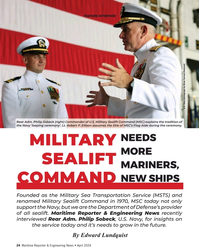 )
April 2024 - Maritime Reporter and Engineering News page: 24
)
April 2024 - Maritime Reporter and Engineering News page: 24as the Military Sea Transportation Service (MSTS) and renamed Military Sealift Command in 1970, MSC today not only support the Navy, but we are the Department of Defense’s provider of all sealift. Maritime Reporter & Engineering News recently interviewed Rear Adm. Philip Sobeck, U.S. Navy, for insights
-
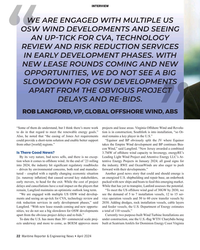 )
April 2024 - Maritime Reporter and Engineering News page: 22
)
April 2024 - Maritime Reporter and Engineering News page: 222030. Adding dredges, rock installation vessels, cable layers Langford. “With new lease rounds coming and new opportu- and feeder vessels, the U.S. Department of Energy estimates nities, we do not see a big slowdown for OSW developments a total of 110 vessels.” apart from the obvious project delays and
-
 )
April 2024 - Maritime Reporter and Engineering News page: 10
)
April 2024 - Maritime Reporter and Engineering News page: 10Maritime Safety © Roman/AdobeStock SIRE 2.0: Navigating the New Horizon of Maritime Safety By Captain Aaron Cooper, Programs Director, OCIMF he maritime industry is on the cusp of a signi? cant preparing vessel operators and vessel assurance teams for the transformation with the launch of the Ship
-
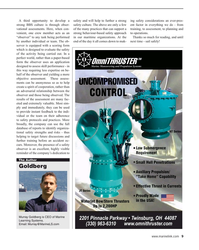 )
April 2024 - Maritime Reporter and Engineering News page: 9
)
April 2024 - Maritime Reporter and Engineering News page: 9A third opportunity to develop a safety and will help to further a strong ing safety considerations an ever-pres- strong BBS culture is through obser- safety culture. The above are only a few ent factor in everything we do - from vational assessments. Here, when con- of the many practices that can
-
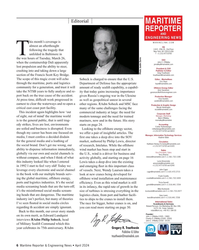 )
April 2024 - Maritime Reporter and Engineering News page: 6
)
April 2024 - Maritime Reporter and Engineering News page: 6of this tragic event will echo Sobeck is charged to ensure that the U.S. Editor - MarineNews Eric Haun through the maritime, ports and logistics Department of Defense has the appropriate [email protected] community for a generation, and trust it will amount of ready sealift capability, a capabil- Offshore
-
 )
April 2024 - Maritime Reporter and Engineering News page: 5
)
April 2024 - Maritime Reporter and Engineering News page: 5Control Your Connectivity Your ?eet’s IT manager, captain, and crew are looking for seamless integration and control for every communication channel found onboard: ® KVH ONE , VSAT, OneWeb, Starlink, 5G and more ™ CommBox Edge from KVH delivers: Prioritization | Channel Balancing | Advance Bonding
-
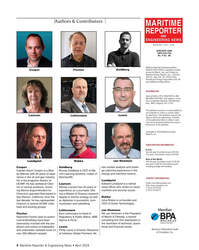 )
April 2024 - Maritime Reporter and Engineering News page: 4
)
April 2024 - Maritime Reporter and Engineering News page: 4Authors & Contributors MARITIME REPORTER AND ENGINEERING NEWS M A R I N E L I N K . C O M ISSN-0025-3448 USPS-016-750 No. 4 Vol. 86 Maritime Reporter/Engineering News (ISSN # 0025-3448) is published monthly Cooper Fischer Goldberg except for March, July, and October by Maritime Activity Reports, Inc.
-
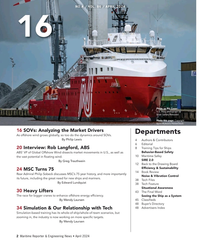 )
April 2024 - Maritime Reporter and Engineering News page: 2
)
April 2024 - Maritime Reporter and Engineering News page: 2the Cover: U.S. Navy photograph by Brian Suriani/Released Photo this page: Copyright Björn Wylezich/AdobeStock 16 SOVs: Analyzing the Market Drivers Departments As offshore wind grows globally, so too do the dynamics around SOVs. By Philip Lewis 4 Authors & Contributors 6 Editorial 8 Training Tips for Ships 20
-
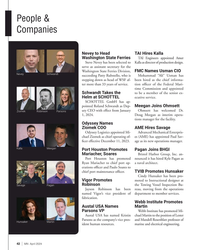 )
April 2024 - Marine News page: 42
)
April 2024 - Marine News page: 42Robinson the Towing Vessel Inspection Bu- Savage Pagan Jayson Robinson has been reau, moving from the operations named Vigor’s vice president of department to member services. fabrication. Webb Institute Promotes Austal USA Names Martin Parsons VP Webb Institute has promoted Mi- Austal USA has named
-
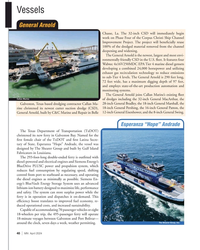 )
April 2024 - Marine News page: 40
)
April 2024 - Marine News page: 40General Arnold, built by C&C Marine and Repair in Belle 12-inch General Eisenhower, and the 8-inch General Swing. Esperanza “Hope” Andrade The Texas Department of Transportation (TxDOT) christened its new ferry in Galveston Bay. Named for the ? rst female chair of the TxDOT and ? rst Latina Secre- tary
